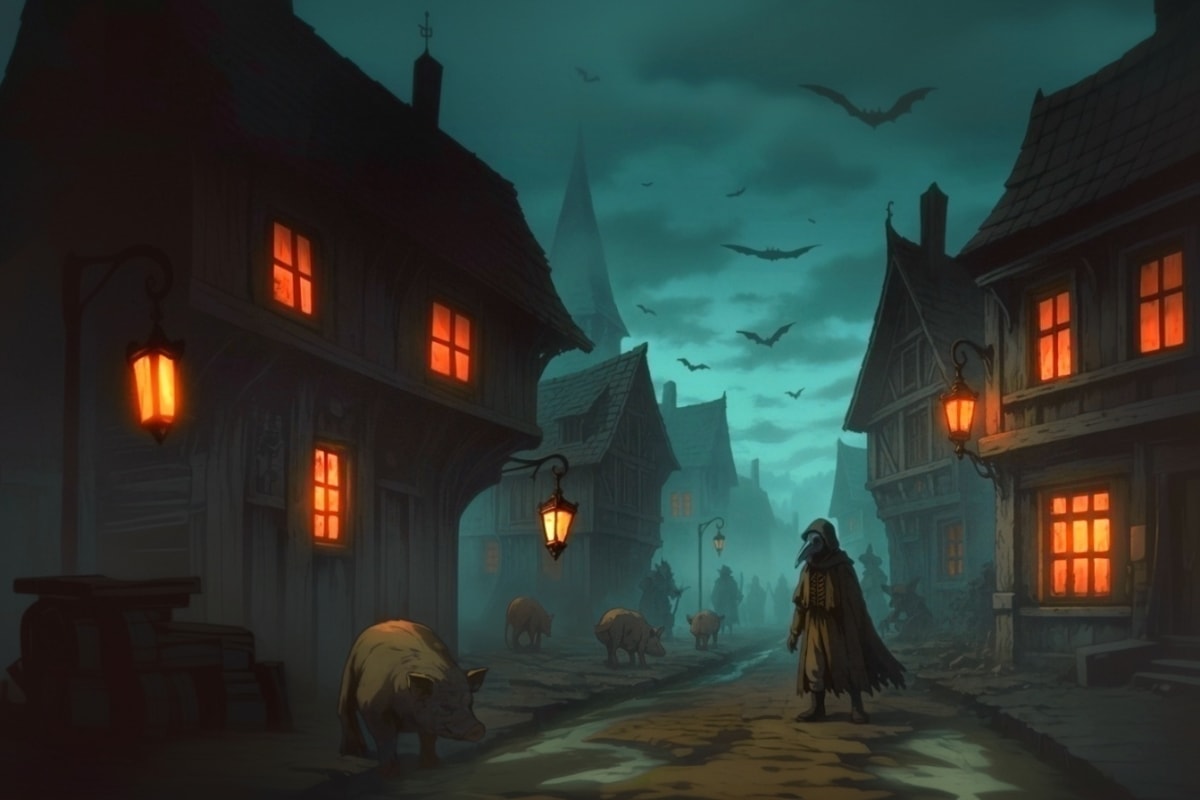Few places inspire such equal parts revulsion and hilarity as Nasty Town, a festering village crawling with filth. Upon entry, one first notices the stench — a thick perfume of rotting refuse, pig dung, stagnant slime, and smoke from cauldrons bubbling with dubious contents.
The locals are no better. Crude goblins jostle with haggard peasants and slobbering pigs for space in the mud-slick streets. The occasional ghoul shuffles through, while an evil lich may stop for a cup of clotted swamp-ale before continuing on to darker business. Stray kobolds and other vermin have made Nasty Town their second home, feasting from its endless decay.
And yet—this cesspool thrives as a hub of the grotesque. For all its filth, Nasty Town is a treasure trove for those willing to stomach it. Wizards, witches, and alchemists of the more daring variety flock here in search of ingredients too vile to be found elsewhere: pig-snot truffles, corpse-moss scraped from crypt walls, slime molds that wriggle when ground, and fungi which only blossom atop dung heaps. In its twisted way, the town is an open-air apothecary, its sewers and midden-pits brimming with exotic reagents for the bold.
The witches, in particular, adore Nasty Town. They revel in its grotesquery, sipping foul brews in crooked taverns where the mugs are never washed and the rats are as much guests as the patrons. For them, the appalling atmosphere is a kind of sanctuary: a place where ugliness is beauty, where the grotesque is celebrated rather than hidden away.
Legends claim that the filth itself is enchanted—that centuries of waste, blood, and foul magic have created a living miasma, a spirit of rot that watches over the town. Some say this is why Nasty Town never dies; it festers eternally, disgusting yet indispensable. Alchemists swear that even its air, bottled correctly, can serve as an ingredient of great (if nauseating) potency.
In the end, Nasty Town embodies its own paradox: abominable, stinking, and vile, yet strangely magnetic. To pass through it is to gag, laugh, and perhaps, if one is unlucky, leave with both a stomachache and a sack of rare magical sludge.
Featured in
Nasty Town
Elf J Trul
Few places inspire such equal parts revulsion and hilarity as Nasty Town, a festering village crawling with filth. Upon entry, one first notices the stench — a thick perfume of rotting refuse, pig dung, stagnant slime, and smoke from cauldrons bubbling with dubious contents.
The locals are no better. Crude goblins jostle with haggard peasants and slobbering pigs for space in the mud-slick streets. The occasional ghoul shuffles through, while an evil lich may stop for a cup of clotted swamp-ale before continuing on to darker business. Stray kobolds and other vermin have made Nasty Town their second home, feasting from its endless decay.
And yet—this cesspool thrives as a hub of the grotesque. For all its filth, Nasty Town is a treasure trove for those willing to stomach it. Wizards, witches, and alchemists of the more daring variety flock here in search of ingredients too vile to be found elsewhere: pig-snot truffles, corpse-moss scraped from crypt walls, slime molds that wriggle when ground, and fungi which only blossom atop dung heaps. In its twisted way, the town is an open-air apothecary, its sewers and midden-pits brimming with exotic reagents for the bold.
The witches, in particular, adore Nasty Town. They revel in its grotesquery, sipping foul brews in crooked taverns where the mugs are never washed and the rats are as much guests as the patrons. For them, the appalling atmosphere is a kind of sanctuary: a place where ugliness is beauty, where the grotesque is celebrated rather than hidden away.
Legends claim that the filth itself is enchanted—that centuries of waste, blood, and foul magic have created a living miasma, a spirit of rot that watches over the town. Some say this is why Nasty Town never dies; it festers eternally, disgusting yet indispensable. Alchemists swear that even its air, bottled correctly, can serve as an ingredient of great (if nauseating) potency.
In the end, Nasty Town embodies its own paradox: abominable, stinking, and vile, yet strangely magnetic. To pass through it is to gag, laugh, and perhaps, if one is unlucky, leave with both a stomachache and a sack of rare magical sludge.


